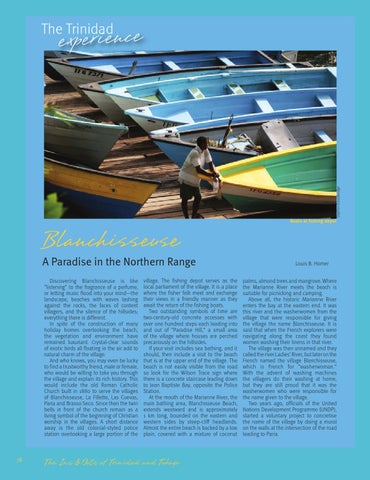The Trinidad
Stephen Broadbridge
experience
Boats at fishing depot
Blanchisseuse A Paradise in the Northern Range Discovering Blanchisseuse is like “listening” to the fragrance of a perfume, or letting music flood into your mind—the landscape, beaches with waves lashing against the rocks, the faces of content villagers, and the silence of the hillsides; everything there is different. In spite of the construction of many holiday homes overlooking the beach, the vegetation and environment have remained luxuriant. Crystal-clear sounds of exotic birds all floating in the air add to natural charm of the village. And who knows, you may even be lucky to find a trustworthy friend, male or female, who would be willing to take you through the village and explain its rich history. This would include the old Roman Catholic Church built in 1880 to serve the villages of Blanchisseuse, La Fillette, Las Cuevas, Paria and Brasso Seco. Since then the twin bells in front of the church remain as a living symbol of the beginning of Christian worship in the villages. A short distance away is the old colonial-styled police station overlooking a large portion of the
78
village. The fishing depot serves as the local parliament of the village. It is a place where the fisher folk meet and exchange their views in a friendly manner as they await the return of the fishing boats. Two outstanding symbols of time are two-century-old concrete accesses with over one hundred steps each leading into and out of “Paradise Hill,” a small area of the village where houses are perched precariously on the hillsides. If your visit includes sea bathing, and it should, then include a visit to the beach that is at the upper end of the village. The beach is not easily visible from the road so look for the Wilson Trace sign where there is a concrete staircase leading down to Jean Baptiste Bay, opposite the Police Station. At the mouth of the Marianne River, the main bathing area, Blanchisseuse Beach, extends westward and is approximately 1 km long, bounded on the eastern and western sides by steep-cliff headlands. Almost the entire beach is backed by a low plain, covered with a mixture of coconut
The Ins & Outs of Trinidad and Tobago
Louis B. Homer
palms, almond trees and mangrove. Where the Marianne River meets the beach is suitable for picnicking and camping. Above all, the historic Marianne River enters the bay at the eastern end. It was this river and the washerwomen from the village that were responsible for giving the village the name Blanchisseuse. It is said that when the French explorers were navigating along the coast they found women washing their linens in that river. The village was then unnamed and they called the river Ladies’ River, but later on the French named the village Blanchisseuse, which is French for “washerwoman.” With the advent of washing machines the villagers do their washing at home, but they are still proud that it was the washerwomen who were responsible for the name given to the village. Two years ago, officials of the United Nations Development Programme (UNDP), started a voluntary project to concretise the name of the village by doing a mural on the walls at the intersection of the road leading to Paria.
